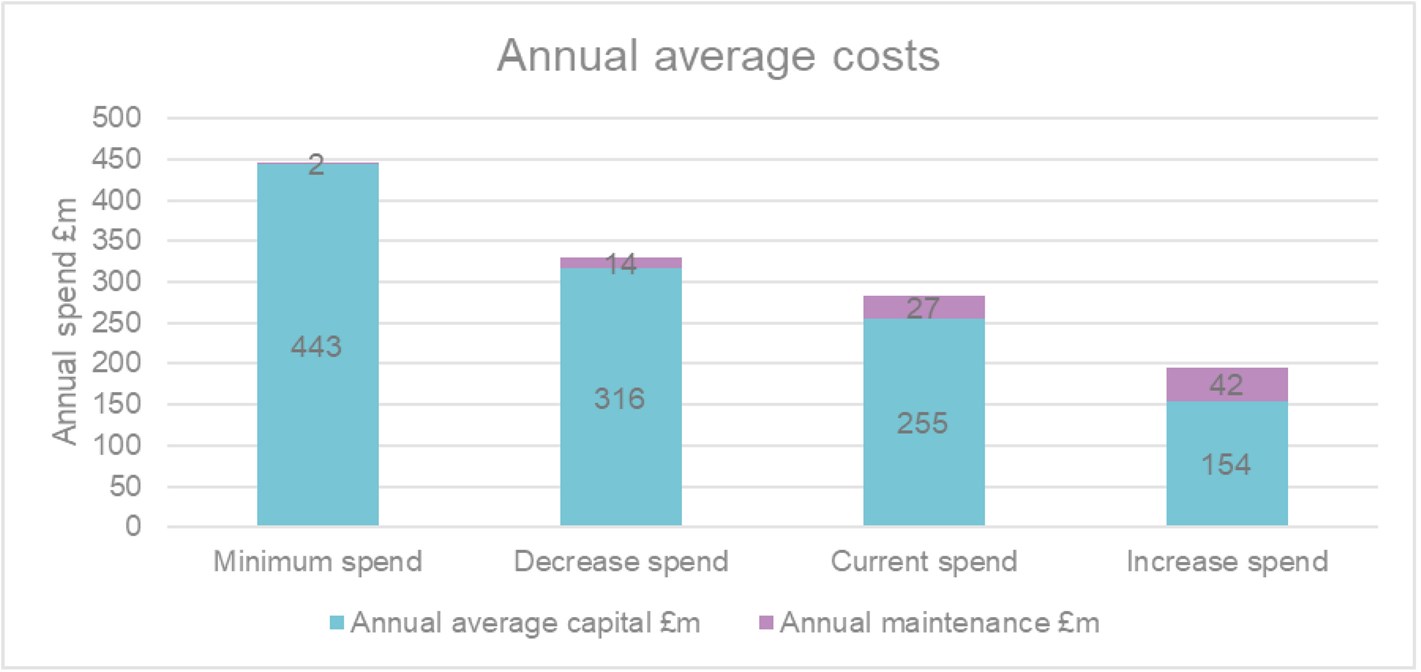 In our submission to the upcoming Budget on 27 October, the ABI has called on the Government to ensure sufficient investment in flood defences.
In our submission to the upcoming Budget on 27 October, the ABI has called on the Government to ensure sufficient investment in flood defences.
Our study Modelling the Impact of Spending on Defence Maintenance on Flood Losses, commissioned the ABI and Flood Re, has shown that every £1 spent on flood defence maintenance saves £7 in capital defence spending.
In this blog, Ruth Power, Catastrophe Risk Consultant at JBA, explores the findings of the study in more detail and highlight why it is vital that the Government recognises the value of investing to maintain this critical infrastructure.
It is adapt, or die."
As if the case for upping our game in managing the UK’s rising flood risk was not important enough, this warning from the Environment Agency’s hard hitting report on the UK’s readiness (or not) for the impacts of climate change hammers home the point. The flood vulnerable communities across the country need no reminding of the urgency in tackling the rising flood risk.
Flood defences play a key role in managing flood risk, today and in the future. In fact, a recent report into the effectiveness of defences in mitigating flood risk in our current climate found that for every £1 spent on flood defence maintenance, £7 is saved in new defence spending.
The joint ABI and Flood Re study, Modelling the Impact of Spending on Defence Maintenance on Flood Losses, is based on new research carried out by flood specialists JBA Risk Management.
It looks at flood defence maintenance spending over 30 years and provides compelling evidence that an increase in spending on existing defences results in a significant reduction in capital spending.
The report makes clear that not properly maintaining flood defences reduces their lifespan and increases costs overall, so not investing enough in maintenance is a false economy.
Flood risk in the UK
Flood is a prevalent risk in all parts of the UK, and likely to become more damaging and costly as the climate continues to change; JBA estimates that one in five UK households are currently at risk from flooding.
Flooding in 2020 from Storms Ciara, Dennis and Jorge affected large areas of the country, with PERILS estimating the cost of insurance industry losses to the UK’s winter 2019/20 floods to be over £368 million.
The current state of defences in the UK
For the purposes of this study, JBA’s researchers analysed flood events from the last 23 years, including those mentioned above, as well as the June/July 2007 floods, the Cumbria 2009 floods and the flooding caused by Storms Desmond, Eva and Frank in 2015/16.
Key findings show that:
- River flood defences in the UK are estimated to reduce national average annual losses (AAL) from flood by 59%.
- National AAL as a result of river flooding to residential and commercial property is estimated at £956 million in the UK without the mitigating effects of flood defences. When the impacts of flood defences are modelled, this reduces to £388 million.
- This highlights the significance of defence infrastructure on financial losses from flooding across the UK.
JBA’s report summarises the condition grade of embankment and wall defences across the UK maintained by governmental organisations, using grades defined by the Environment Agency’s Condition Assessment Manual (CAM).
Defences classed as “fair” have some defects that could reduce performance but the risk of failure due to breach remains low. Unless failure of a defence would result in significant damage, maintaining a defence in fair condition is considered to be an acceptable target.
JBA’s research, based on Environment Agency and Natural Resources Wales spatial flood defences datasets supplemented by JBA’s own data, reveals that the vast majority of defences (walls and embankments) across the UK (~92%) are in a fair or better condition.
Approximately 6% are considered poor requiring further investigation and repair, while 2% are considered very poor requiring immediate replacement or significant reconstruction.
Figure 1 (below) shows the figures for England and Wales; as figures were not available for Scotland and Northern Ireland, it was assumed that defences in these areas were in a fair (grade 3) condition.

Figure 1: Defence condition grade (wall and embankment) breakdown by country. Graphs show state of defences from 1 (very good) to 5 (very poor).
Impact of spending on defence lifespan and capital costs
Utilising JBA’s UK Flood Model with the addition of a new probabilistic defence failure module, the research looked at four hypothetical spending scenarios:
- Minimum spending – reduce maintenance spending to the legal minimum
- Decrease current maintenance spending by 50%
- Maintain current maintenance spending (current target condition grade 3)
- Increase current maintenance spending by 50%
Current Environment Agency spend, in England, on maintenance, repair and restoration of assets is around £210 million to £230 million per year, while its latest budget for flood and coastal erosion risk management shows that funding will increase by almost 25% for 2021-2022.
However, the data shows that because the life of defences is extended when a higher level of maintenance is provided, the capital spend requirement will actually decrease as a result of this increase in funding (see Figure 2).

Figure 2: Average annual upkeep costs for the four scenarios.
The cost impact of this is that for every £1m of extra maintenance spending, there will be an annual capital cost saving of almost £7m.
The lifespan of defences is increased by an average of eight years if maintenance spending is increased by 50%, whereas a cut in spending of 50% decreases the typical lifespan of a defence by 12 years.
In financial terms, this means that for every £1 of reduced maintenance spend, there will be an increase of over £4 in capital cost annually.
A key finding of the study is that, over the analysis period, increasing the level of maintenance spending to 150% of the baseline results in the lengthening of the reliable lifespan of defences so that capital expenditure is delayed. The cost impact of this is that for every £1m of extra maintenance spending, there will be an annual capital cost saving of almost £7m.
This study presents a compelling argument that increased spending on the maintenance of defences saves money in both the short and long term.
New defences are vital, but should be looked at in parallel with maintenance. So when spending in this area is being reviewed, JBA’s research supports the view of the ABI and Flood Re that spending on defence maintenance is key to building UK communities’ resilience to flood. Flood risk in the UK is expected to only worsen as a result of climate change and flood defence investment will no doubt play a key role.
